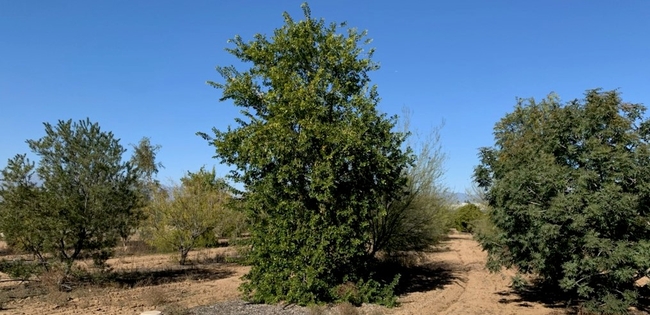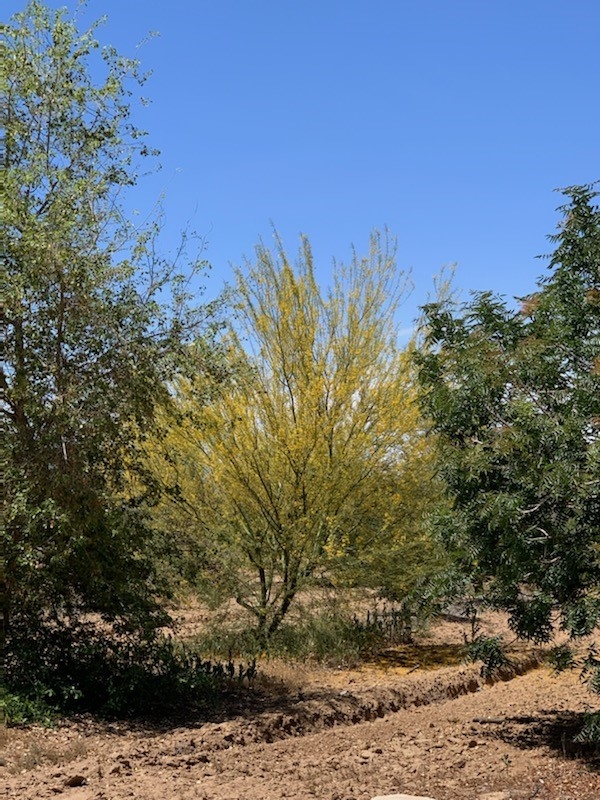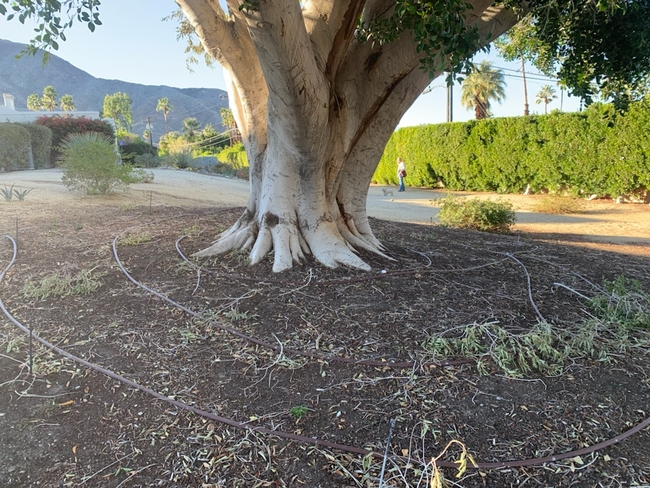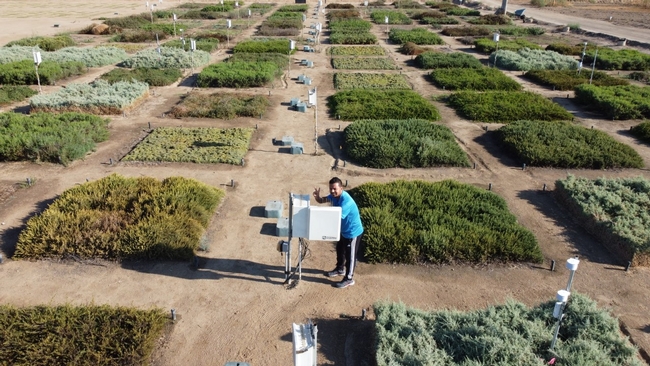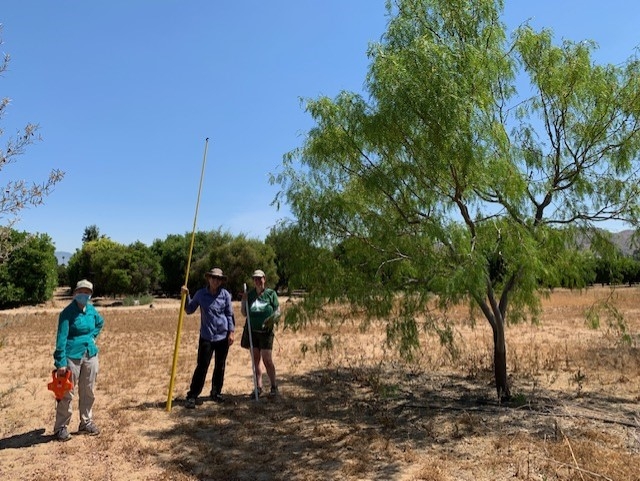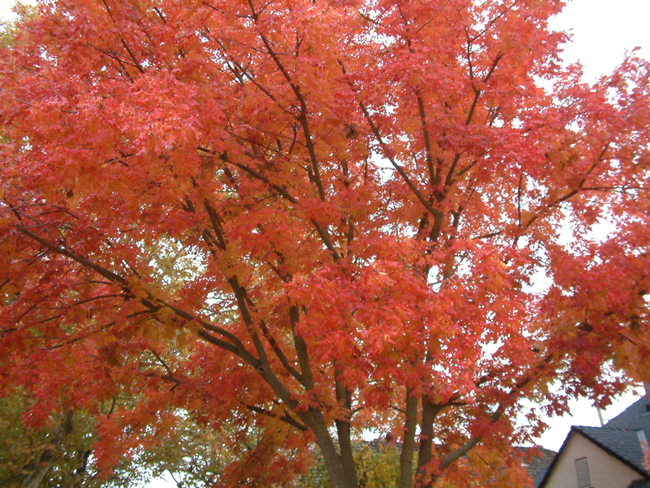
Posts Tagged: Hartin
Now is the time to plant climate-ready trees, says UCCE researcher
In a drought-prone region like Southern California, working with Mother Nature is not only wise but necessary, according to Janet Hartin, UC Cooperative Extension horticulture advisor for Los Angeles, San Bernardino and Riverside counties, who studies climate-ready trees.
In 2020, Governor Newsom launched the California Climate Action Corps, empowering Californians to protect their communities from the impacts of climate change. Newsom's call to action emphasizes the need for long-term and sustainable solutions like Hartin's research, which urges Southern California to care for existing trees and plant new ones.
In collaboration with the U.S. Forest Service and other UC Cooperative Extension scientists, Hartin is amid a 20-year research study identifying trees suitable for California's different climate zones. Her work provides a comprehensive understanding of trees and their benefits related to human and environmental health, particularly as Californians navigate climate change's evolving challenges.
One of these concerns is urban heat islands. UHIs are areas in which heat is reradiated from paved concrete or asphalt surfaces. In cities covered in asphalt, like Los Angeles, average temperatures can become six degrees hotter than surrounding areas.
To reduce urban heat islands, she has been working with community organizations to plant trees. In March, for example, Hartin teamed up with the Inland Empire Resource Conservation District to increase tree canopy in the Inland Empire.
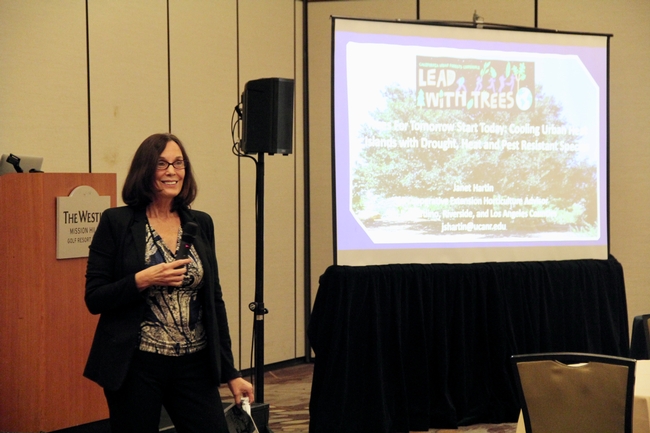
Trees keep cities cool
To keep the city cool, some Los Angeles neighborhoods are repainting pavements with reflective coating. According to a 2020 study published in Environmental Research Letters, reflective coating can decrease pavement temperatures up to 10 degrees. As helpful as this is, augmenting urban landscapes to include heat-, drought- and pest-resistant tree species, whether native or not, can significantly reduce the impacts of urban heat islands too.
“Trees can cool impervious surfaces by 40 to 65 degrees,” Hartin said. During a 2021 study, in May and June Hartin discovered that unshaded asphalt could be more than 60 degrees hotter than shaded asphalt during late spring and early summer in inland and desert cities.
Other than providing shade, trees are effective at deflecting the sun's radiation and cooling the atmosphere through evapotranspiration. Given that they absorb and store carbon as well, trees lessen the impacts of pollution from fossil fuels.
“A well-tended mature landscape tree can absorb 40 tons of carbon over its lifespan,” said Hartin.
In a 2021 blog post, Hartin suggests trees be selected based on their adaptation to the “micro-climate” in each particular landscape, noting factors to consider like shade, proximity to buildings, space needs below and above ground, soil type and water source. She also recommends the Sunset Western Climate Zone maps for reference, noting that they are “more precise than USDA zones for our warmer climates.”
Based on the study with the U.S. Forest Service examining the performance of 12 species of underplanted but promising landscape trees at UC Riverside, favorable candidates include bubba desert willow and maverick thornless honey mesquite for their drought resistance, and red push pistache for its drought and heat resistance.
Tamara Hedges, executive director of UC Riverside Palm Desert Center and member of the Board of Directors for the Oswit Land Trust, agrees that trees are important in our fight against climate change:
“Through our partnerships with the UC California Naturalist and the Master Gardener Programs and many other nonprofits in the Coachella Valley, natural ecosystems are being protected and expanded and built environments cooled through the planting of appropriate tree species. These UC/USFS studies go a long way in identifying new underrepresented tree species."
General tips for planting
For California, planting in early fall through late winter provides ample time for trees to establish a strong root system before enduring the summer heat. Doing so also means that natural rainfall can fulfill water needs, as opposed to solely relying on irrigation systems.
Unlike newly planted trees, mature trees should be watered infrequently but deeply. Watering too often can reduce the level of oxygen in the rootzone and result in waterlogged soils prone to crown and root rots. 
During the fall, trees only need about 15% of the water they would require in the summer. When watering, keep the tree trunk dry. Because the roots of the tree grow outward and are usually a foot deep into the ground, Hartin recommends watering the area around the trunk rather than the trunk itself. This will also help avoid water waste.
“Trees not adapted to the climate they're planted in and not receiving proper care are much more susceptible to invasive pests like shothole borers and diseases,” said Hartin. “Even the loss of one front yard tree can significantly reduce shade, increase the surrounding temperature, and diminish energy savings.”
Drought or Disease?
With ongoing drought and local water restrictions in place in many areas of California, you may...
Save trees first: Tips to keep them alive during drought
Trees essential to lowering temperatures, cooling ‘heat islands'
Water restrictions prompted by the drought are driving Californians to prioritize how they will use their limited water. Because landscape irrigation is a major water use for many households, residents are looking outdoors to conserve water.
When choosing which landscape plants to save, “trees come first,” said Janet Hartin, UC Cooperative Extension area environmental horticulture advisor for San Bernardino, Los Angeles and Riverside counties. “Healthy communities need trees. Fortunately new California water restrictions allow for provisions to ensure trees receive adequate water to stay alive and healthy.”
“Mature trees are instrumental in cooling urban heat islands and we can't afford to lose them and start all over,” Hartin said. “Shade from mature trees can reduce surface temperatures by as much as 65 degrees in asphalt-covered parking lots. Shade from a single tree can reduce these surface temperatures from 165 to less than 100 degrees when air temperatures reach 110 degrees. Even with air temperatures in the 90s, surface temperatures can reach 140 degrees.”
In addition to providing shade, trees absorb and store carbon dioxide, release oxygen, enhance pollinators and wildlife habitat, filter pollutants from air and water and can reduce energy use, according to Hartin. Because trees take years to grow, they aren't as easily replaced as other plants.
As residents let lawns go brown, she recommends watering trees that are near or surrounded by lawn.
“If a tree is in the middle of a lawn, it is almost certainly watered by lawn irrigation,” Hartin said. “If it's not on a separate drip system, drag out a hose and allow the water to slowly trickle into the soil early in the morning or in the evening. Deep watering for two hours once every couple of weeks will keep most established trees alive."
In most jurisdictions, watering restrictions do not apply to hand watering and hand-held watering devices such as hoses, which may be used for longer periods of time than the restrictions permit otherwise. However, watering may be restricted in all cases to prescribed times of day.
“Check to see if your jurisdiction also requires a hose shutoff valve,” Hartin said.
“For fruit trees, we may have to forgo fruit production for a year or so. There may not be enough water to support fruit production, but the goal is to keep the trees alive during the drought,” she said.
She recommends watering trees away from the trunk, halfway between the trunk and the dripline – where the foliage ends and rain drips off the leaves – because “roots grow outward quite a distance as well as downward. Leave the hose on so the water is just trickling out,” she said. “You want water to seep into the soil and encourage the roots to grow deeper. The slow water flow will seep down a foot or so and the roots will follow, which will help anchor the tree. Move the hose around every half hour to hour in quadrants around the tree for more even watering.”
Don't have time to move the hose? Hartin suggests getting a soaker hose and wrapping it in concentric circles 2 to 3 feet apart.
“Soaker hoses are made from recycled tire rubber and allow water to slowly ooze out of the pores along the hose, distributing the water fairly evenly throughout the hose length. Avoid using soaker hoses longer than 75 feet due to pressure issues.”
To reduce evaporation around the tree, spreading mulch a few inches from trunk can help.
“Dark mulches can heat the environment so it's best not to use them,”Hartin said. “If you are in a fire-prone area, don't use organic wood-based mulches because they are flammable. Use decomposed gravel or pebbles, rock-based products instead. To keep sunlight out and discourage weeds, large wood chip mulches should be maintained 3-4-inches deep and smaller inorganic mulches at 1-2 inches.”
Residents may want to maintain some grass for children and pets because bare feet and paws can sustain serious burns on surfaces hotter than 120 degrees.
“People don't realize how hot fake grass can get,” Hartin said. “Research I conducted last summer in the Coachella Valley and Redlands found that surface temperatures of synthetic lawns can be more than 65 degrees higher than living turf and groundcover surfaces on several dates in between May and August.”
For California lawns, there are drought-tolerant grasses that can thrive on 30% less water than bluegrass and other cool season varieties. Examples are buffalograss and bermudagrass. They still require maintenance, such as mowing, but are great for play and recreational surfaces for people and pets.
Jim Baird, UC Cooperative Extension turf specialist based at UC Riverside, said, “Turfgrasses offer numerous recreational, aesthetic, and environmental benefits including player safety, property value, mental health, erosion control, groundwater recharge and surface water quality, organic chemical decomposition, carbon sequestration and environmental cooling.”
There are also non-turf groundcovers that are drought resistant.
“As they transpire, plants cool the environment. We have more and more drought-resistant alternatives to high-water-requiring plants on the market now, and that's where we should be going,” Hartin said.
For people considering replacing their lawns and adding new landscape plants, she recommends planting low-water using groundcovers in the fall.
“It's too hot to plant in summer and even native and drought-resistant plants require water several times week until they get established,” she said.
Most counties have a UC Master Gardener Program with a helpline staffed by well-trained volunteers dispensing advice to help keep plants alive and recommend plants that are well-suited for the local environment. Find a local UC Master Gardener Program at https://mg.ucanr.edu/FindUs.
University of California Cooperative Extension
Drought and Landscape Tree Care Resources
Keeping Plants Alive Under Drought and Water Restrictions (English)
https://anrcatalog.ucanr.edu/pdf/8553.pdf
Mantener las plantas del exterior vivas con poca agua (Spanish)
https://anrcatalog.ucanr.edu/pdf/8628.pdf
Prioritizing Trees Under Drought and Water Restrictions (5-minute video)
https://www.youtube.com/watch?v=CTKLlJgdLVk
Tips to Keep Your Landscape Trees Alive During Drought
Landscape Tree Irrigation to Maximize Tree Health, Benefits, and Beauty
Landscape Tree Irrigation 101
Top 10 Ways to Conserve Water in Your Landscape and Garden
Use of Graywater in Urban Landscapes in California
https://anrcatalog.ucanr.edu/Details.aspx?itemNo=8536
The importance of trees to cool urban heat islands
Partnering for California
Spring 2021 proved to be one of the hottest in California, breaking heat records in several cities. It was a perfect opportunity to plant “climate-ready landscape trees” in inland cities identified in a study conducted by the University of California Cooperative Extension in partnership with the U.S. Forest Service.
The idea of bringing together community groups and volunteers to enhance tree canopies that cool urban heat islands --which can be more than 50 degrees hotter than surrounding areas -- in the Redlands area was spawned by Janet Hartin, UC Cooperative Extension environmental horticulture advisor for Riverside, San Bernardino and Los Angeles counties.
It became a reality when Mandy Parkes, district manager of Inland Empire Resource Conservation District, and Shelli Stockton of the University of Redlands received partner grants from the Climate Action Corps to start a nursery and get the “climate-ready landscape trees” in the ground. To date, nearly 100 trees from the study have been planted, including over 40 at the Redlands Sports Complex. As the volunteers in Redlands know, planting trees helps to cool these heat islands. After a long day of digging and planting in June, the volunteers were satisfied with their hard work and looked forward to sharing their experiences.
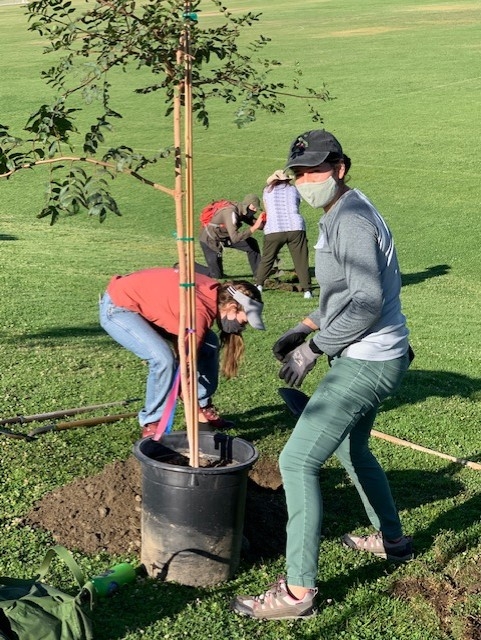
According to Parkes: “The project is moving along quickly due to excellent work of the Climate Action Fellows; inspiring research and support from Janet Hartin and the UC Cooperative Extension Master Gardeners who will ensure that residents continue to receive proper tree care help long after the planting ends; outreach by Mario Saucedo and his Redlands-based community action nonprofit organization, Common Vision Coalition.”
Saucedo, chairman of Common Vision Coalition, said, "It came together, all of us round-tabling on how we could do this pilot project and reach out to the community residents and offer them free trees for their homes."
Once the community accepted the project, the outreach began. James Berry of the California Climate Action Corps was excited after they got the green light from the city of Redlands to plant the trees.
"They are from two different species," said Berry. "The Western Bud and the Red Push Pistache. Both are heat tolerant and drought tolerant, making them ideal for the high temperatures we are facing, and the ones in the coming years as a result of the climate change."
“Our ‘Trees for Tomorrow' workshop we held last fall for city planners, wholesale and retail nursery personnel, landscape architects, landscapers, water districts community groups, and Master Gardeners resulted in pockets of multidisciplinary projects, tree planting projects across Southern California, including the Redlands project. The Redlands project exemplifies the core principles of a well thought out and executed project that includes long-term tree care, a real key to maximizing benefits of trees over their lifespans of 50 years and more.”
With a statewide drought forcing water restrictions, people are looking into options to save water. Hartin advises against sacrificing any trees.
"One of the things that I think is important to prioritize is to make sure that when we have to reduce our water use outside in urban areas, we maintain our trees as a top priority," said Hartin. "If that means for a year or two that our lawns and our flowering beds are going to go by the wayside, then that's just the situation."
She recommends something as simple as dragging a hose out and into the tree's drip line, making sure not to water the trunk, but the other side of the drip line where the active root system is.
"Climate-ready tree study: update for Southern California communities" by E. Gregory McPherson, Alison Berry, Natalie van Doorn, Janet Hartin, Jim Downer, Darren Haver and Erica Teach is published at https://www.fs.usda.gov/treesearch/pubs/60414.
To learn more about the study or how to combat climate change with trees:
“Trees for tomorrow start today.”
“Lush urban forest can help communities face climate change.”
Plant a Tree. Leave a Legacy!
Do you have Spring Fever? If you have adequate space, why not leave a legacy to your children's children by planting a tree? When the right species is planted in the right location with the right care, landscape trees can be enjoyed for 100 years or more. Landscape trees cool urban heat islands, absorb carbon dioxide, filter toxic chemicals from soil preventing them from polluting our waterways, reduce soil and water erosion, reduce internal energy needs and related costs, provide habitat, and beautify neighborhoods.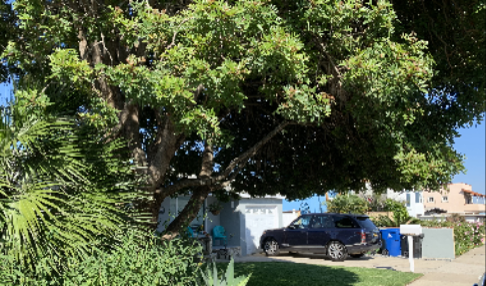
Spring is a much better times to plant a container landscape tree in California than is summer. Trees incur far less stress if they've been in the ground several weeks rather than having to immediately adapt to high summer temperatures. Cooler weather allows plants to establish roots in their new ‘home' before the harshness of summer sets in. (Deciduous bare-root fruit trees, on the other hand, should be planted during the winter when they are dormant.) Choose recommended species for your climate and micro-climate.
Choose trees based on your Sunset climate zone (more precise than USDA zones for California since they include impacts of high temperatures as well as low temperatures) and your microclimate (shade, soil conditions, space, etc.). Four of my favorite search engines that allow one to search by multiple criteria (size, water needs, flower color, ecosystem functions, pest susceptibility, etc.) are: Inland Valley Garden Planner: https://inlandvalleygardenplanner.org/; Cal Poly, Pomona: https://selectree.calpoly.edu;California Native Plant Society: http://www.cnps.org/cnps/grownative/lists.php; and WUCOLS IV (Water Use Classification of Landscape Species): http://ucanr.edu/sites/WUCOLS
Avoid circled, girdled roots. Remember to inspect the root system of container trees. Avoid purchasing specimens with severely circled and girdled roots. Root pruning will not solve the problem and the resulting tree is much more prone to failure later. This occurs because the upper portion of the tree continues to grow and expand while the root system lacks the breadth and architectural strength to support the tree. Many times a tree will look fine for several years and - seemingly - very suddenly topple in winds that otherwise it could sustain with a more adequate root system. Only when the tree falls does the owner actually notice firsthand that the root system is the same size it was when the tree was planted years before!
Check drainage before you plant. Dig a hole where you are planning on planting the tree, fill it with water, and make sure it completely drains within 24-hours. If it doesn't drain, don't plant a tree there. In some cases, trees are carefully selected based on species and location only to perish ten or more years later due to poor drainage and water-logged soil. Trees often die in these situations due to a lack of aeration setting them up for disease-causing fungal pathogens.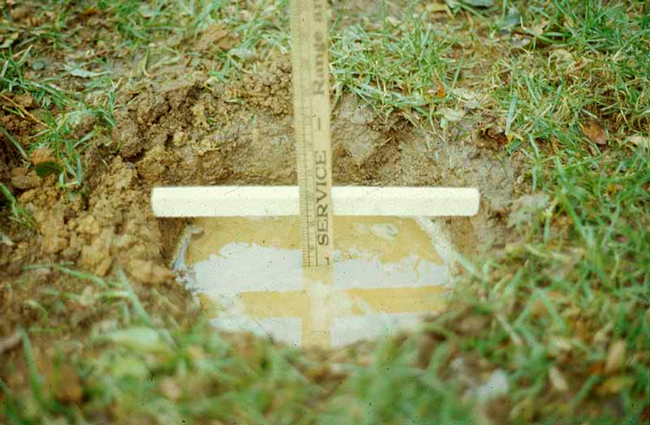
Planting the tree. Dig a hole at least 2-1/2 times the width of the container (in clay or compacted soils make the hole at least 4-5 times wider) up to two inches shallower than the depth of the tree in the container to compensate for settling. Use a shovel or trowel to roughen the soil on the sides of the hole to encourage root growth into the native soil. Remove the tree from the container along with any loose soil that covers the lower part of the trunk. Carefully place the tree in the planting hole, keeping the trunk flare (the area where the trunk widens and connects with the roots) 1-2 inches above the existing grade. Gently fill the hole with the same soil that was removed. Do not add soil amendments or compost, another common cause of circled and kinked roots. Irrigate the tree immediately after planting through the entire root system and slightly deeper. Keep in mind that soils with appreciable clay content absorb water more slowly than sandier soils and need to be watered longer but less often. Water newly planted container trees often through their establishment period, even if they are drought tolerant species. Recently transplanted trees have a small volume of roots that dry out very quickly. Water newly planted trees regularly through the first season. Trees in sandy soils require more frequent watering than do trees in heavier soils. (After trees are fully established, irrigation frequency should be reduced but more water should be added during each irrigation.)
Avoid staking trees unless necessary. Stake trees only if they were staked at the nursery and/or if they are planted in a wind-prone area. Remember to loosen ties on nursery stock before they girdle the trunk. Gently secure any tree requiring staking with two opposing flexible ties on the lower half of the tree, allowing the tree to gently blow in the wind to encourage lower trunk strength. Avoids taking trees tightly, restricting flex. As the tree matures, remember to loosen ties and aim for removing stakes entirely if the tree is self-supporting.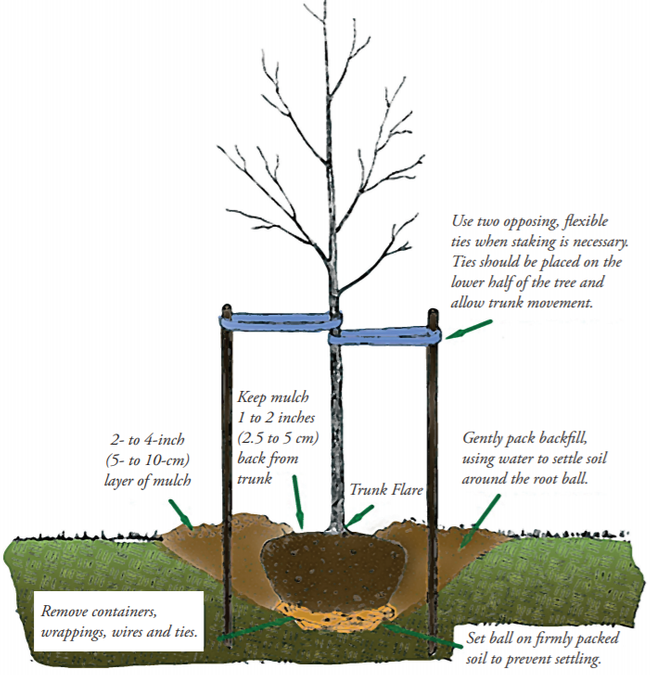
Pruning. Avoid heavy pruning at the time of planting. Remove only broken branches, crossed branches and suckers at the base of the tree.
Fertilizing. Most trees have received adequate nutrition in the nursery and do not need fertilizer at the time of planting.
Mulching. Apply a 2-4 inch layer of mulch three or more inches away from the tree trunk. Organic mulches such as woodchips and compost should be applied and maintained at a depth of 3-4 inches to prevent weed seeds from sprouting. Inorganic mulches (gravel, pebbles, etc.) should be maintained at 2-3 inches. In fire-prone areas, organic mulches near the urban/forest interface should be avoided. Remember to irrigate below the mulch.
For more information on tree planting and care and all other home gardening and landscape topics, contact the UCCE San Bernardino County Master Gardener Helpline at mgsanbern@ucanr.edu

